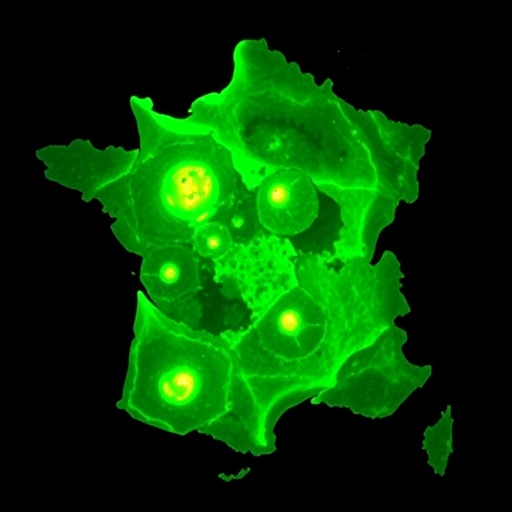
Credit: James Macleod, University of Cambridge/EPSRC
An image of spectacular swirling graphene ink in alcohol, which can be used to print electrical circuits onto paper, has won the overall prize in a national science photography competition, organised by the Engineering and Physical Sciences Research Council (EPSRC).
'Graphene — IPA Ink', by James Macleod, from the University of Cambridge, shows powdered graphite in alcohol which produces a conductive ink. The ink is forced at high pressure through micrometre-scale capillaries made of diamond. This rips the layers apart resulting in a smooth, conductive material in solution.
The image, came first in two categories, Innovation, and Equipment & Facilities, as well as winning overall against many other stunning pictures, featuring research in action, in the EPSRC's competition — now in its fourth year. James Macleod, explained how the photograph came about: "We are working to create conductive inks for printing flexible electronics and are currently focused on optimising our recipe for use in different printing methods and for printing onto different surfaces. This was the first time we had used alcohol to create our ink and I was struck by how mesmerising it looked while mixing."
The competition's five categories were: Eureka & Discovery, Equipment & Facilities, People & Skills, Innovation, and Weird & Wonderful. Other winning images feature:
- A 3D printed gripper which was programmed to lift delicate, geometrical complex objects like a lightbulb, pneumatically rather than using sensors.
- A scanning electron microscope image showing the surface of a silicon chip, patterned to create a one metre ultra-thin optical wire, just one millionth of a metre wide made into a spiral and wrapped into an area the size of a square millimetre.
- Researcher Michael Coto with a local student in Vingunguti, Dar es Salaam, Tanzania, testing and purifying polluted water using new solar active catalysts.
- An image captured on an iPhone 4s through an optical microscope that shows the variety of textures appearing on the surface of a silicon solar cell, not dissimilar to pyramids surrounded by a sea of dunes in a desert, but with the size of a human hair.
- Tiny biodegradable polymer particles resembling golf balls being developed to target infectious diseases and cancers. Only 0.04mm across, they form part of scaffolds which are being studied to see if they can support the growth of healthy new cells.
One of the judges was physicist, oceanographer and broadcaster, Dr Helen Czerski, Lecturer at UCL, she said: "Scientists and engineers are often so busy focusing on the technical details of their research that they can be blind to what everyone else sees first: the aesthetics of their work. Science is a part of our culture, and it can contribute in many different ways. This competition is a wonderful reminder of the emotional and artistic aspects of science, and it's great that EPSRC researchers have found this richness in their own work."
Congratulating the winners and entrants, Professor Tom Rodden, EPSRC's Deputy Chief Executive, said: "The quality of entries into our competition demonstrates that EPSRC-funded researchers are keen to show the world how beautiful and interesting science and engineering can be. I'd like to thank everyone who entered; judging was really difficult. "These stunning images are a great way to engage the public with the research they fund, and inspire everyone to take an interest in science and engineering."
###
The competition received over 100 entries which were drawn from researchers in receipt of EPSRC funding.
The judges were:
Martin Keene – Group Picture Editor – Press Association
Dr Helen Czerski – Lecturer at the Department of Mechanical Engineering, University College London
Professor Tom Rodden – EPSRC's Deputy Chief Executive
The first, second and third prize winning images with descriptions are all available to download from the EPSRC website http://www.epsrc.ac.uk
Notes to editors:
For further information and images please contact the EPSRC Press Office on 01793 444 404 or email [email protected]
The Engineering and Physical Sciences Research Council (EPSRC) As the main funding agency for engineering and physical sciences research, our vision is for the UK to be the best place in the world to Research, Discover and Innovate.
By investing £800 million a year in research and postgraduate training, we are building the knowledge and skills base needed to address the scientific and technological challenges facing the nation. Our portfolio covers a vast range of fields from healthcare technologies to structural engineering, manufacturing to mathematics, advanced materials to chemistry. The research we fund has impact across all sectors. It provides a platform for future economic development in the UK and improvements for everyone's health, lifestyle and culture.
We work collectively with our partners and other Research Councils on issues of common concern via Research Councils UK. http://www.epsrc.ac.uk
Media Contact
EPSRC Press Office
[email protected]
01-793-444-404
http://www.epsrc.ac.uk
############
Story Source: Materials provided by Scienmag




